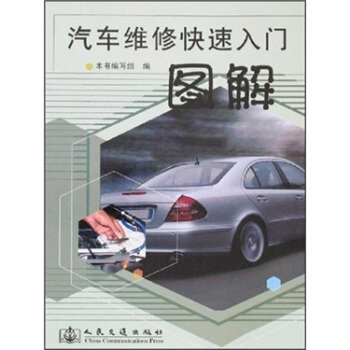![工程控制论(英文版) [Engineering Cybernetics]](https://pic.qciss.net/11757806/56051d7aN24d9f72f.jpg)

具体描述
内容简介
《工程控制论(英文版)》的目的是把一般性概括性的理论和实际工程经验很好地结合起来,对工程技术各个系统的自动控制和自动调节理论作一个全面的探讨。它一方面奠定了工程控制论这门技术科学的理论基础,另一方面指出这门新学科今后的几个研究方向。《工程控制论(英文版)》最初是用英文写的。现在的汉文版是在钱学森先生的指导下,翻译英文版并且参照俄文译本略加修改和补充而成。
《工程控制论(英文版)》曾荣获中国科学院1956年度一等科学奖金。
目录
Chapter 1 Introduction1.1 Linear Systems of Constant Coefficients
1.2 Linear Systems of Variable Coefficients
1.3 Nonlinear Systems
1.4 Engineering Approximation
Chapter 2 Method of Laplace Transform
2.1 Laplace Transform and Inversion Formula
2.2 Application to Linear Equations with Constant Coefficients
2.3 "Dictionary" of Laplace Transforms
2.4 Sinusoidal Forcing Function
2.5 Response to Unit Impulse
Chapter 3 Input, Output, and Transfer Function
3.1 First-Order Systems
3.2 Representations of the Transfer Function
3.3 Examples of First-Order Systems
3.4 Second-Order Systems
3.5 Determination of Frequency Response
3.6 Composition of a System from Elements
3.7 Transcendental Transfer Functions
Chapter 4 Feedback Servomechanism
4.1 Concept of Feedback
4.2 Design Criteria of Feedback Servomechanisms
4.3 Method of Nyquist
4.4 Method of Evans
4.5 Hydrodynamic Analogy of Root Locus
4.6 Method of Bode
4.7 Designing the Transfer Function
4.8 Multiple-Loop Servomechanisms
Chapter 5 Noninteracting Controls
5.1 Control of a Single-Variable System
5.2 Control of a Many-Variable System
5.3 Noninteraction Conditions
5.4 Response Equations
5.5 Turbopropeller Control
5.6 Turbojet Engine with Afterburning
Chapter 6 Alternating-current Servomechanisms and Oscillating Control
Servomechanisms
6.1 Alternating-Current Systems
6.2 Translation of the Transfer Function to a Higher Frequency
6.3 Oscillating Control Servomechanisms
6.4 Frequency Response of a Relay
6.5 Oscillating Control Servomechanisms with Built-in Oscillation
6.6 General Oscillating Control Servomechanism
Chapter 7 Sampling Servomechanisms
7.1 Output of a Sampling Circuit
7.2 Stibitz-Shannon Theory
7.3 Nyquist Criterion for Sampling Servomechanisms
7.4 Steady-State Error
7.5 Calculation of F; (s)
7.6 Comparison of Continuously Operating with Sampling Servomechanisms
7.7 Pole of F2(s) at Origin
Chapter 8 Linear Systems with Time Lag
8.1 Time Lag in Combustion
8.2 Satche Diagram
8.3 System Dynamics of a Rocket Motor with Feedback Servo
8.4 Instability without Feedback Servo
8.5 Complete Stability with Feedback Servo
8.6 General Stability Criteria for Time-Lag Systems
Chapter 9 Linear Systems with Stationary Random Inputs
9.1 Statistical Description of a Random Function
9.2 Average Values
9.3 Power Spectrum
9.4 Examples of the Power Spectrum
9.5 Direct Calculation of the Power Spectrum
9.6 Probability of Large Deviations from the Mean
9.7 Frequency of Exceeding a Specified Value
9.8 Response of a Linear System to Stationary Random Input
9.9 Second-Order System
9.10 Lift on a Two-Dimensional Airfoil in an Incompressible Turbulent Flow
9.11 Intermittent Input
9.12 Servo Design for Random Input
Chapter 10 Relay Servomechanisms
10.1 Approximate Frequency Response of a Relay
10.2 Method of Kochenburger
10.3 Other Frequency-Insensitive Nonlinear Devices
10.4 Optimum Performance of a Relay Servomechanism
10.5 Phase Plane -
10.6 Linear Switching
10.7 Optimum Switching Function
10.8 Optimum Switching Line for Linear Second-Order Systems
10.9 Multiple-Mode Operation
Chapter 11 Nonlinear Systems
11.1 Nonlinear Feedback Relay Servomechanism
11.2 Systems with Small Nonlinearity
11.3 Jump Phenomenon
11.4 Frequency Demultiplication
11.5 Entrainment of Frequency
11.6 Asynchronous Excitation and Quenching
11.7 Parametric Excitation and Damping
Chapter 12 Linear System with Variable Coefficients
12.1 Artillery Rocket During Burning
12.2 Linearized Trajectory Equations
12.3 Stability of an Artillery Rocket
12.4 Stability and Control of Systems with Variable Coefficients
Chapter 13 Control Design by Perturbation Theory
13.1 Equations of Motion of a Rocket
13.2 Perturbation Equations
13.3 Adjoint Functions
13.4 Range Correction
13.5 Cutoff Condition
13.6 Guidance Condition
13.7 Guidance System
13.8 Control Computers
Chapter 14 Control Design with Specified Criteria
14.1 Control Criteria
14.2 Stability Problem
14.3 General Theory for First-Order Systems
14.4 Application to Turbojet Controls
14.5 Speed Control with Temperature-Limiting Criteria
14.6 Second-Order Systems with Two Degrees of Freedom
14.7 Control Problem with Differential Equation as Auxiliary Condition
14.8 Comparison of Concepts of Control Design
Chapter 15 Optimalizing Control
15.1 Basic Concept
15.2 Principles of Optimalizing Control
15.3 Considerations on Interference Effects
15.4 Peak-Holding Optimalizing Control
15.5 Dynamic Effects
15.6 Design for Stable Operation
Chapter 16 Filtering of Noise
16.1 Mean-Square Error
16.2 Phillips's Optimum Filter Design
16.3 Wiener-Kolmogoroff Theory
16.4 Simple Examples
16.5 Applications of Wiener-Kolmogoroff Theory
16.6 Optimum Detecting Filter
16.7 Other Optimum Filters
16.8 General Filtering Problem
Chapter 17 Ultrastability and Multistability
17.1 Ultrastable System
17.2 An Example of an Ultrastable System
17.3 Probability of Stability
17.4 Terminal Fields
17.5 Multistable System
Chapter 18 Control of Error
18.1 Reliability by Duplication
18.2 Basic Elements
18.3 Method of Multiplexing
18.4 Error in Executive Component
18.5 Error of Multiplexed Systems
18.6 Examples
Index
出版后记
精彩书摘
《工程控制论(英文版)》:On—off servomechanisms have the great advantage that comparatively simple systems of this kind can be made to handle large amounts of power.This is often difficult to achieve with servomechanisms of other types.On the other hand, on—off servomechanisms are definitely nonlinear systems, and, as will be shown in Chap.10, their performances tend to be inferior to those of the systems we have considered previously.Briefly, an oscillating control servomechanism is a modification of an on—off servomechanism, which enables us to secure the advantage of linearity without sacrificing the advantage of large power—carrying capacity.
Before proceeding to the treatment of oscillating control servomechanisms proper, we shall present a general theoretical result, upon which the theory of all such systems is based.Let us consider a device having the following property: According as the input signal x(t) is positive or negative, the output signal y(t) is + A or —A, where A is a fixed constant.We may think of such a device as an ideal relay, an on—off system with zero threshold.Suppose that the input signal to the relay is
x(t)=E0sinωt + kE0 sin ωt (6.8)
where E0, k, ω0 and ω are constants.In connection with oscillating control servomechanisms, the term E0 sin ω0t will be a persistent oscillation in the system, and kE0 sin ωt will be an applied signal or modulating signal.We shall calculate the corresponding output y(t) presently.
……
前言/序言
用户评价
这部《工程控制论》(英文版)的封面设计简直是工业美学的典范,那种深邃的蓝和冷峻的银色字体搭配,立刻就让人联想到精密计算和严谨的系统思维。我记得第一次翻开它时,那种厚重的质感和纸张的细腻触感,仿佛预示着里面蕴含着知识的重量。虽然我不是控制理论的科班出身,但冲着这个名字——“工程控制论”,我本能地期待它能为我打开一扇通往复杂系统管理的大门。我希望能从中找到那种将混乱现象抽象化为可控模型的哲学路径,而不是一味沉溺于晦涩的数学公式。我尤其关注那些关于系统辨识和最优控制的章节,希望它们能以一种贴近实际工程案例的方式呈现,而不是仅仅停留在理论的象牙塔中。这本书如果能用生动的图表和实际工业生产线上的例子来佐证其理论的有效性,那无疑会大大提升阅读体验,让人感觉到这不仅仅是一本教科书,更是一部指导实践的工具书。我对作者在处理非线性系统和不确定性环境下的控制策略方面抱有极高的期望,毕竟现代工程面临的挑战越来越复杂,简单的线性模型早已无法完全应对现实的千变万化。
评分读完前三分之一,我开始怀疑这本书的受众定位是否准确。它充满了对系统稳定性的深刻洞察,对李雅普诺夫稳定性判据的讨论也十分详尽,但作为一个主要从事电气工程背景的工程师,我真正需要的是如何有效地设计和实现一个满足特定能效标准的功率电子控制系统。我对这本书期望的是能提供一套清晰的流程,指导如何从物理模型出发,快速建立一个合适的数学模型,然后选择最经济、最可靠的控制算法进行部署。这本书更多地是在探讨“什么是一个好的控制理论”,而不是“如何用现成的理论解决当前的问题”。其中对最优控制理论的介绍虽然详尽,但往往要求读者具备极高的数值计算能力,这对于快速迭代的工程项目而言,效率太低。如果能有一个专门的附录,详细对比几种常用控制方法(比如LQR与H无穷控制)在计算复杂度和实时性能之间的权衡,那该书的实用价值会大大提升,而不是让读者在浩瀚的理论中迷失方向。
评分初读此书,给我的最大感觉是作者对于理论体系构建的野心,简直是将控制论的哲学基石和工程应用的可能性进行了一次宏大的整合。它似乎不是一本专门针对初学者的入门读物,而更像是写给那些已经掌握了基础控制理论,希望在学科交叉点上寻求突破的专业人士看的。我印象特别深刻的是开篇对“反馈”这一核心概念的深入探讨,作者似乎想挖掘出控制论超越传统工程学的边界,触及到生物学乃至社会系统的本质。这种宏大叙事的手法固然令人敬佩,但也带来了一个问题:在大量的哲学思辨和通用模型构建之后,具体的、可操作的工程实现细节反而显得单薄了。我渴望看到更多关于实时系统、分布式控制网络或者现代物联网环境下的感知与执行机制如何与这些高级理论相结合的探讨,但这些内容似乎被“理论的纯粹性”所牺牲了。这使得这本书更像是一部高屋建瓴的“方法论”著作,而非一本解决具体工程难题的“操作手册”。
评分这本书的排版布局简直是反人类的——如果你只是想快速查阅某个特定算法的步骤,那无异于在迷宫里找出口。字体选择偏小,行距又挤得可怜,每次阅读都得架上老花镜,眼睛着实受罪。更别提那些穿插在正文中的复杂数学推导,它们像幽灵一样占据了大量的篇幅,对于我这种更侧重于应用层面理解的读者来说,简直是一种折磨。我原本以为,作为“工程”控制论,它会更倾向于介绍那些在实际硬件平台上易于实现的算法,比如经典的PID调参的进阶应用,或者一些基于模糊逻辑的直观控制方法。然而,我看到的更多是拉普拉斯变换、状态空间模型以及各种复杂的矩阵运算,看得我直犯迷糊。我期待的是一种“拿来即用”的工具箱,而不是一本要求我重新学习高等数学的参考书。如果它能增加一个专门的章节,深入剖析几种主流PLC(可编程逻辑控制器)平台如何实现书中的某些控制策略,那价值可就不可估量了,可惜全书似乎避开了这些“工程细节”。
评分这本书的翻译质量实在不敢恭维,很多关键术语的中文对应词汇显得生硬且不统一,这严重影响了阅读的流畅度和对概念的准确把握。举个例子,某个核心概念在不同章节中被翻译成了三四种不同的说法,这对于需要进行精确对比和理解的读者来说,无疑是一种智力上的挑战。我本来想通过这本书来学习如何为我正在负责的一个小型自动化流程设计一个更具鲁棒性的控制器,特别是针对那些周期性干扰下的性能优化。我希望书中能提供一些关于如何量化“鲁棒性”以及如何通过迭代优化过程逐步逼近理想控制器的案例分析。然而,我发现书中的案例大多是高度理想化的、教科书式的标准系统,缺乏现实世界中常见的噪声、传感器漂移和执行器饱和等“脏数据”的干扰。这使得书中的结论虽然在数学上完美无缺,但在工程实践中却显得空中楼阁,难以直接移植。
评分好
评分不错。
评分不错
评分第一本全英文的书,读起来有点吃力啊,内容需要很多数学知识,吃力+1,书绝对是好书,但要是买完看不进去就不合适了啊,fighting????
评分经典,致敬天之骄子,科学工程大师,物流快递师也非常敬业出色,京东物流就是快!
评分大师经典!
评分办公室购买 还不错 京东物流不错?
评分办公室购买 还不错 京东物流不错?
评分不错。
相关图书
本站所有内容均为互联网搜索引擎提供的公开搜索信息,本站不存储任何数据与内容,任何内容与数据均与本站无关,如有需要请联系相关搜索引擎包括但不限于百度,google,bing,sogou 等
© 2025 book.teaonline.club All Rights Reserved. 图书大百科 版权所有
















![中华人民共和国国家标准(GB 50877-2014):防火卷帘、防火门、防火窗施工及验收规范 [Dode for Installation and Acceptance of the Resistant Slutters,Fire Resistant Doorsets and Fire Resistant Windows] pdf epub mobi 电子书 下载](https://pic.qciss.net/11585993/548aafbfNb5b196de.jpg)



